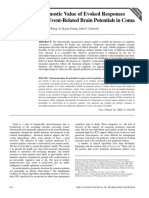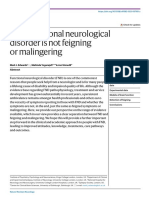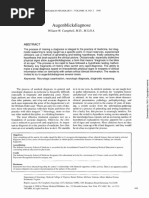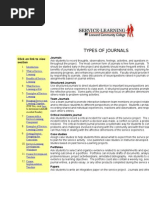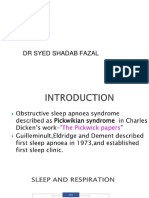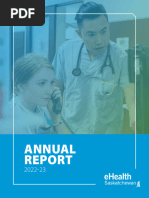Imp5
Imp5
Uploaded by
neeraj dograCopyright:
Available Formats
Imp5
Imp5
Uploaded by
neeraj dograCopyright
Available Formats
Share this document
Did you find this document useful?
Is this content inappropriate?
Copyright:
Available Formats
Imp5
Imp5
Uploaded by
neeraj dograCopyright:
Available Formats
EDITORIAL
Surgery and Anesthesia: Healing the Body but
Harming the Brain?
Gregory Crosby, MD, and Deborah J. Culley, MD
F rom the origins of surgical anesthesia in the 1840s
through the late 1990s, the prevailing view has been
that the brain emerged unscathed from the assault of
surgery and the pharmacologic coma that we call general
is no consensus on the cause and, therefore, on whether the
anesthesiologist can prevent or mitigate it. Indeed, because
it is not a clinical diagnosis and the criteria used to define
it are not uniform, there is debate about whether it even
anesthesia. Since then, the literature has been awash with exists as a unique entity. Evered et al.3 suggest in this issue
studies suggesting that is not always the case and that of the Journal that POCD is, in fact, perhaps not a new or
sometimes, in an effort to heal the body, we might be harming distinct entity because the incidence in older patients is
the brain. However, when, why, and how this happens is a similar after procedures of very different invasiveness/
matter of considerable debate. That debate is winding up complexity (coronary artery bypass, elective hip replace-
rather than down and is unlikely to be resolved anytime soon. ment, and coronary angiography). Hence, they suggest that
In the spirit of fueling, if not resolving, the debate, the section the surgical experience just unmasks brain compromise
on Neuroscience in Anesthesiology and Perioperative Medi- that was already present preoperatively.
cine in this issue of Anesthesia & Analgesia pulls together a Delirium, on the other hand, is a common and well-
collection— consisting of original work, reviews, a meeting defined clinical syndrome. As reviewed in this issue of the
summary, and an opinion piece—that speaks to various Journal by Rudolph and Marcantonio4 and by Hughes and
aspects of this subject. There is something here for everyone Pandharipande,5 delirium occurs in up to 50%– 80% of elderly
interested in the topic, and even for those who might just be surgical patients, the criteria and tools to diagnose it are
curious, but before you dive into the specific articles, we agreed upon, and it presages poor short- and long-term
thought it would be useful to put them in the context of outcomes. Importantly, there is evidence that medication
current themes/hypotheses about adverse perioperative cog- choices, depth of anesthesia, and treatment of pain can affect
nitive outcomes. delirium risk.4 –7 Nonetheless, the anesthesia community has
The first theme has to do with the nature of the surgery been somewhat inattentive to delirium, perhaps because it is
or medication-induced brain dysfunction and whether it is erroneously believed to be a transient and unimportant con-
clinically important. The brain, for all its complexity, has dition. Nothing could be farther from the truth, and the
only so many ways to malfunction. Excluding stroke and reviews by Rudolph and Marcantonio4 and by Hughes and
seizures, which typically result from major physiologic or Pandharipande5 make it clear that there are opportunities to
pathologic events, perioperative brain dysfunction mani- improve cognitive outcomes for patients at risk for delirium
fests mainly as abnormalities in cognition/thinking. Post- with seemingly small changes in patient management.
operative cognitive dysfunction (POCD), a mild but possibly The cognitive consequences of surgical and anesthetic
long-lasting cognitive fogginess that is “diagnosed” only by events in young children are the most enigmatic. That is
neurocognitive testing, is probably most familiar to the because unlike the elderly—in whom cognitive syndromes
anesthesia community. Within the first week after surgery, (delirium and POCD) were identified first and animal
30%–50% of patients have POCD, with no difference by studies looking at potential mechanisms followed—the
age, and at 3 months after surgery about 10%–15% do, but sequence is reversed on the question of whether sedative
at this point the problem is limited to the elderly.1,2 There and anesthetic agents are neurotoxic in young children.
That worrisome story started with animal work and, be-
From the Harvard Medical School, Department of Anesthesiology, Peri- cause results of epidemiological studies examining an
operative, and Pain Medicine, Brigham and Women’s Hospital, Boston,
Massachusetts. association between anesthesia and surgery during early
Accepted for publication February 16, 2011. childhood and learning disabilities later in life are few and
Funding: NIH GM088817 (to GC) and GM077057 (to DJC). conflicting,8,9 it is not clear that there is a clinical correlate.
The authors declare no conflicts of interest. In essence, in the elderly we started with a victim (delirium,
Reprints will not be available from the authors. POCD) and are looking for a weapon, whereas in children
Address correspondence to Gregory Crosby, MD, Department of Anes- we started with a weapon (anesthetic/sedative drug-
thesiology, Harvard Medical School, Brigham & Women’s Hospital, 75 induced neurodegeneration in animals) and are searching
Francis Street, Boston, MA 02115. Address e-mail to gcrosby@zeus.bwh.
harvard.edu. for a victim (clinical problem).
Copyright © 2011 International Anesthesia Research Society Another major theme relates to the putative causes of
DOI: 10.1213/ANE.0b013e3182160431 adverse cognitive outcomes. There are 3 general theories:
May 2011 • Volume 112 • Number 5 www.anesthesia-analgesia.org 999
EDITORIAL
medications, surgery, and the patient. Evidence that our young patients. And it is not just about age alone. This is
drugs are responsible is most consistent for developmental illustrated by articles in this issue of the Journal by Leung et
neurotoxicity. A major and consistent feature of the pathol- al.22 and by Jankowski et al.23 showing, respectively, that
ogy in the developing animal brain following exposure to a preoperative frailty and cognitive impairment are indepen-
variety of common sedative and anesthetic agents is cell dent risk factors for development of delirium postopera-
and synapse loss.10 –12 This has been convincingly demon- tively. Likewise, the report of Evered et al.,3 which shows a
strated in cell culture models, rodents, and primates, even similar incidence of POCD in older patients after proce-
when systemic physiology is well controlled, implying that dures of very different invasiveness, points away from the
it is a direct effect of the medications. Learning and social surgical and anesthetic details and toward the intrinsic
deficits in adulthood have also been identified in animals characteristics of the patient. This could have profound
exposed to sedative/anesthetic medications in the neonatal implications. If much of the cognitive dysfunction observed
period.10,13 As such, anesthetic-induced neurodegeneration after surgery in elders is simply unmasking a preexisting
is the prevailing theory driving concerns about general problem such as mild cognitive impairment, which afflicts
anesthesia in young children. However, even this is not about 1 in 5 community-dwelling elders,24 our terminology
straightforward; exposure to sedative/anesthetic medica- would have to change. POCD might be a misnomer be-
tions after the peak of synaptogenesis increases synapse cause the condition may be neither “post” nor “operative.”
numbers14 and, in in vitro work using human neuronlike “Illness-related cognitive dysfunction” may be a more
cells and published in this issue of the Journal, Lin et al. accurate descriptor. More importantly, our focus would
challenge the idea that volatile agents injure neurons in logically shift to identifying in advance those at risk. This is
humans.15 There is also major disagreement about the at the heart of a provocative Open Mind piece by Silbert et
ability of medications to cause long-lasting changes in the al.25 in this issue. They essentially propose that we use
old brain. In the mature brain, anesthetic-induced neuro- surgical preadmission test centers to screen patients for
apoptosis appears to be a minor event, but accumulation of mild cognitive impairment or dementia much as we do for
the neurotoxic proteins amyloid  and phosphorylated , cardiovascular disease in at-risk groups. One approach
both of which are implicated in the pathogenesis of Alzhei- would be to add cognitive evaluation to the routine preop-
mer disease, has been observed.16,17 Likewise, persistent erative assessment of elders, a course that would make
cognitive deficits have been reported in old animals after good sense given the frequency and seriousness of periop-
exposure to some common anesthetic agents.18 However, erative cognitive morbidity in elders but that is not fool-
as is well summarized by Eckenhoff in his report of the proof.26 Another might be to take the lead on utilizing
Second International Perioperative Neurotoxicity Work- biomarkers to more accurately and reliably diagnose cog-
shop in this issue of the Journal, there is still considerable nitive compromise27 so we can make better-informed clini-
controversy about whether anesthetic agents contribute to cal management decisions perioperatively. Regardless of
development of POCD and dementia.19 In contrast, as what one thinks of these specific ideas, there is no disputing
reviewed here by Rudolph and Marcantonio4 and by the general concept that with elders it is essential to
Hughes and Padharipande,5 evidence is reasonably good explicitly consider the functional state of the brain both
that both specific sedative agents and depth of anesthesia before and after surgery.
can contribute to delirium. As the articles in the collection of this month’s issue of
The surgical theory of causation involves inflammation. the Journal illustrate, there has been a remarkable transfor-
This idea is obviously more appealing to anesthesiologists mation over the past 10 to 15 years in how we view the
than accepting that our drugs are harmful. Moreover, there brain’s response to the duress of surgical illness, sedation,
is ample evidence that under other circumstances, inflam- and general anesthesia. The specter of cognitive dysfunc-
mation can adversely affect cognitive performance (con- tion after noncentral nervous system surgery is alarming to
sider the subtle cognitive cloudiness that one often feels patients, families, and anesthesiologists alike, but it is also
during a viral illness) and lead eventually to neurodegen- a strong motivator for learning more and doing better so
eration.20 Thus far, however, a relationship between that our work to heal the body does not harm the brain.
surgery and subsequent cognitive dysfunction has been Please read, enjoy, and be stimulated by the articles in this
demonstrated experimentally mostly in young animals and month’s collection to do just that.
over the short term, and the clinical story is circumstantial.
Nor does the inflammation hypothesis exclude anesthetic
REFERENCES
agents as a potential cause of cognitive dysfunction because 1. Moller JT, Cluitmans P, Rasmussen LS, Houx P, Rasmussen H,
recent work indicates that some of these agents trigger Canet J, Rabbitt P, Jolles J, Larsen K, Hanning CD, Langeron O,
neuroinflammatory changes in the brain.21 It remains to be Johnson T, Lauven PM, Kristensen PA, Biedler A, van Beem H,
seen, therefore, whether inflammation explains cognitive Fraidakis O, Silverstein JH, Beneken JE, Gravenstein JS. Long-
term postoperative cognitive dysfunction in the elderly
dysfunctions that occur perioperatively, but it is a promis- ISPOCD1 study. ISPOCD investigators. International Study of
ing hypothesis that deserves further study. Post-Operative Cognitive Dysfunction. Lancet 1998;351:857– 61
Perhaps the most intriguing recent theory about the 2. Monk TG, Weldon BC, Garvan CW, Dede DE, van der Aa MT,
cause of perioperative cognitive dysfunction in the older Heilman KM, Gravenstein JS. Predictors of cognitive dysfunc-
surgical patient is that it is their “fault” and has little to do tion after major noncardiac surgery. Anesthesiology
2008;108:18 –30
with the surgeons or us. There is some face validity to this 3. Evered L, Scott DA, Silbert BS, Maruff P. Postoperative cogni-
argument: even after the same surgery, delirium and tive dysfunction is independent of type of surgery and anes-
persistent POCD are more common in old patients than in thetic. Anesth Analg 2011;112:1179 – 85
1000 www.anesthesia-analgesia.org ANESTHESIA & ANALGESIA
Surgery and Anesthesia: Healing the Body but Harming the Brain?
4. Rudolph JL, Marcantonio ER. Postoperative delirium: acute 15. Lin D, Feng C, Cao M, Zuo Z. Volatile anesthetics may not
change with long-term implications. Anesth Analg 2011; induce significant toxicity to human neuron-like cells. Anesth
112:1202–11 Analg 2011;112:1194 – 8
5. Hughes CG, Pandharipande PP. The effects of perioperative 16. Xie Z, Culley DJ, Dong Y, Zhang G, Zhang B, Moir RD, Frosch
and intensive care unit sedation on brain organ dysfunction. MP, Crosby G, Tanzi RE. The common inhalation anesthetic
Anesth Analg 2011;112:1212–7 isoflurane induces caspase activation and increases amyloid
6. Sieber FE, Zakriya KJ, Gottschalk A, Blute M-R, Lee HB, beta-protein level in vivo. Ann Neurol 2008;64:618 –27
Rosenberg PB, Mears SC. Sedation depth during spinal anes- 17. Whittington RA, Virág L, Marcouiller F, Papon M-A, Khoury
thesia and the development of postoperative delirium in NBE, Julien C, Morin F, Emala CW, Planel E. Propofol directly
elderly patients undergoing hip fracture repair. Mayo Clin increases tau phosphorylation. PLoS ONE 2011;6:e16648
Proc 2010;85:18 –26 18. Culley DJ, Baxter MG, Crosby CA, Yukhananov R, Crosby G.
7. Fong H, Sands LP, Leung JM. The role of postoperative Impaired acquisition of spatial memory 2 weeks after isoflu-
analgesia in delirium and cognitive decline in elderly patients: rane and isoflurane–nitrous oxide anesthesia in aged rats.
a systematic review. Anesth Analg 2006;102:1255– 66 Anesth Analg 2004;99:1393–7
8. Bartels M, Althoff RR, Boomsma DI. Anesthesia and cognitive 19. Eckenhoff RG. Second International Perioperative Neurotoxic-
performance in children: no evidence for a causal relationship. ity Workshop summary. Anesth Analg 2011;112:1253–5
Twin research and human genetics 2009;12:246 –53 20. Perry VH, Cunningham C, Holmes C. Systemic infections and
9. Wilder RT, Flick RP, Sprung J, Katusic SK, Barbaresi WJ, inflammation affect chronic neurodegeneration. Nat Rev Im-
Mickelson C, Gleich SJ, Schroeder DR, Weaver AL, Warner munol 2007;7:161–7
DO. Early exposure to anesthesia and learning disabilities in a 21. Wu X, Lu Y, Dong Y, Zhang G, Zhang Y, Xu Z, Culley DJ,
population-based birth cohort. Anesthesiology 2009;110: Crosby G, Marcantonio ER, Tanzi RE, Xie Z. The inhalation
796 – 804 anesthetic isoflurane increases levels of proinflammatory
10. Jevtovic-Todorovic V, Hartman RE, Izumi Y, Benshoff ND, TNF-␣, IL-6, and IL-1. Neurobiol Aging 2010 Dec 28. [Epub
Dikranian K, Zorumski CF, Olney J, Wozniak DF. Early ahead of print]
exposure to common anesthetic agents causes widespread 22. Leung JM, Tsai TL, Sands LP. Preoperative frailty in older
neurodegeneration in the developing rat brain and persistent surgical patients is associated with early postoperative de-
learning deficits. J Neurosci 2003:876 – 82 lirium. Anesth Analg 2011;112:1199 –201
11. Head BP, Patel HH, Niesman IR, Drummond JC, Roth DM, 23. Jankowski CJ, Trenerry MR, Cook DJ, Buenvenida SL, Stevens
Patel PM. Inhibition of p75 neurotrophin receptor attenuates SR, Schroeder DR, Warner DO. Cognitive and functional
isoflurane-mediated neuronal apoptosis in the neonatal central predictors and sequelae of postoperative delirium in elderly
nervous system. Anesthesiology 2009;110:813–25 patients undergoing elective joint arthroplasty. Anesth Analg
12. Brambrink AM, Evers AS, Avidan MS, Farber NB, Smith DJ, 2011;112:1186 –93
Zhang X, Dissen GA, Creeley CE, Olney JW. Isoflurane- 24. Petersen RC, Roberts RO, Knopman DS, Boeve BF, Geda YE,
induced neuroapoptosis in the neonatal rhesus macaque brain. Ivnik RJ, Smith GE, Jack CR. Mild cognitive impairment: ten
Anesthesiology 2010;112:834 – 41 years later. Arch Neurol 2009;66:1447–55
13. Satomoto M, Satoh Y, Terui K, Miyao H, Takishima K, Ito M, 25. Silbert BS, Evered L, Scott DA, Maruff P. Anesthesiology must
Imaki J. Neonatal exposure to sevoflurane induces abnormal play a greater role in patients with Alzheimer’s disease. Anesth
social behaviors and deficits in fear conditioning in mice. Analg 2011;112:1242–5
Anesthesiology 2009;110:628 –37 26. Crosby G, Culley DJ, Hyman BT. Preoperative cognitive as-
14. Briner A, De Roo M, Dayer A, Muller D, Habre W, Vutskits L. sessment of the elderly surgical patient: A call for action.
Volatile anesthetics rapidly increase dendritic spine density in Anesthesiology 2011;in press
the rat medial prefrontal cortex during synaptogenesis. Anes- 27. Herskovits AZ, Growdon JH. Sharpen that needle. Arch Neu-
thesiology 2010;112:546 –56 rol 2010;67:918 –20
May 2011 • Volume 112 • Number 5 www.anesthesia-analgesia.org 1001
You might also like
- Gymmaxxing and Leanmaxxing GuideDocument24 pagesGymmaxxing and Leanmaxxing Guidetomasvasconcelos2024No ratings yet
- 1.psychiatric Neuroscience - Incorporating Pathophysiology Into Clinical Case Formulation - ClinicalKeyDocument43 pages1.psychiatric Neuroscience - Incorporating Pathophysiology Into Clinical Case Formulation - ClinicalKeyClaudia0% (1)
- Bradley's Neurology in Clinical Practice, 2-Volume Set. 7th Edition. ISBN 0323287832, 978-0323287838Document23 pagesBradley's Neurology in Clinical Practice, 2-Volume Set. 7th Edition. ISBN 0323287832, 978-0323287838janislattonawe95% (20)
- Integrative Neuroscience and Personalized Medicine (Evian Gordon MD PHD, Stephen Koslow PHD) (Z-Library)Document346 pagesIntegrative Neuroscience and Personalized Medicine (Evian Gordon MD PHD, Stephen Koslow PHD) (Z-Library)Naomi SjarifudinNo ratings yet
- Integrando Terapia Manual e Neurociencia Da DorDocument274 pagesIntegrando Terapia Manual e Neurociencia Da DorÁtila Hanemann100% (2)
- The Fascial Distortion Model BookDocument10 pagesThe Fascial Distortion Model BooksimonyanNo ratings yet
- Gelb, Douglas J - Introduction To Clinical Neurology (2016, Oxford University Press)Document545 pagesGelb, Douglas J - Introduction To Clinical Neurology (2016, Oxford University Press)EMIN3M100% (9)
- GAS Testing Form - SampleDocument2 pagesGAS Testing Form - SampleMarvie Robles100% (1)
- Introduction To Clinical Neurology-Gelb, D.Document545 pagesIntroduction To Clinical Neurology-Gelb, D.Kathleen Kate Yumul100% (2)
- Understanding Psychic AttacksDocument36 pagesUnderstanding Psychic AttacksMwagaVumbi100% (10)
- Emmy's & Maddy's First Service Encounter - Service MarketingDocument38 pagesEmmy's & Maddy's First Service Encounter - Service Marketingskpaul21991% (11)
- Urinary Tract Infections1Document35 pagesUrinary Tract Infections1salmaNo ratings yet
- What Doctors Feel: How Emotions Affect the Practice of MedicineFrom EverandWhat Doctors Feel: How Emotions Affect the Practice of MedicineRating: 4 out of 5 stars4/5 (31)
- Introduction To Clinical Neurology. 5th Edition. ISBN 0190467193, 978-0190467197Document23 pagesIntroduction To Clinical Neurology. 5th Edition. ISBN 0190467193, 978-0190467197rosellebleiere100% (12)
- Psychosurgery, Epilepsy Surgery, or Surgical Psychiatry: The Tangled Web of Epilepsy and Psychiatry As Revealed by Surgical OutcomesDocument2 pagesPsychosurgery, Epilepsy Surgery, or Surgical Psychiatry: The Tangled Web of Epilepsy and Psychiatry As Revealed by Surgical Outcomesximena sanchezNo ratings yet
- Medico Legal Aspects of Severe Traumatic Brain InjuryDocument17 pagesMedico Legal Aspects of Severe Traumatic Brain InjuryIrv CantorNo ratings yet
- Psico CirugiaDocument24 pagesPsico CirugiaJuliana MartinezNo ratings yet
- Thesis Placebo EffectDocument8 pagesThesis Placebo Effectbshpab74100% (4)
- Jamaneurology Burke 2019 VP 190011Document2 pagesJamaneurology Burke 2019 VP 190011joao victorNo ratings yet
- Cognitive Changes After Surgery in Clinical Practice., 978-3319757223Document23 pagesCognitive Changes After Surgery in Clinical Practice., 978-3319757223andreiorvahnec100% (14)
- 1925 The Correction of Flexion, Adduction and Internal Rotation Deformities of The LE Resulting From CP of Childhood. CWMDocument4 pages1925 The Correction of Flexion, Adduction and Internal Rotation Deformities of The LE Resulting From CP of Childhood. CWMJoseloNo ratings yet
- A Biological Substrate For Somatoform DisordersDocument5 pagesA Biological Substrate For Somatoform DisordersRakhmad HarissonoNo ratings yet
- Link Between Emotional and PhysicalDocument5 pagesLink Between Emotional and PhysicalsumeetkantkaulNo ratings yet
- Wang 2004Document13 pagesWang 2004Ricardo Jose De LeonNo ratings yet
- Postoperative Cognitive Dysfunction and Dementia: What We Need To Know and DoDocument11 pagesPostoperative Cognitive Dysfunction and Dementia: What We Need To Know and Dofulgentius juliNo ratings yet
- Conversion Syndromes in Neurology: Clinical Characteristics of 16 PatientsDocument6 pagesConversion Syndromes in Neurology: Clinical Characteristics of 16 PatientsLiezeth Ayala FNo ratings yet
- Potential Conflicts of Interest: 2012 American Neurological Association 983Document2 pagesPotential Conflicts of Interest: 2012 American Neurological Association 983Khuen Yen NgNo ratings yet
- Our Understanding of Depression Is Changing. Why Isn't Treatment - Scientific AmericanDocument4 pagesOur Understanding of Depression Is Changing. Why Isn't Treatment - Scientific AmericanPatykNo ratings yet
- Edwards Mark J Why Functional Neurological Disorder IsDocument11 pagesEdwards Mark J Why Functional Neurological Disorder IsSiddika PanjwaniNo ratings yet
- Maj. 2013. Adherence To Psychiatric Treatments and The Public Image of PsychiatryDocument2 pagesMaj. 2013. Adherence To Psychiatric Treatments and The Public Image of PsychiatryAndrés EstradéNo ratings yet
- The Profession of Neurological Medicine: Martin A. Samuels, MD, DSC, Faan, MacpDocument4 pagesThe Profession of Neurological Medicine: Martin A. Samuels, MD, DSC, Faan, MacpAhmad mughalNo ratings yet
- Ecstasy Research: Will Increasing Observational Data Aid Our Understanding of MDMA?Document2 pagesEcstasy Research: Will Increasing Observational Data Aid Our Understanding of MDMA?Cyberterton4No ratings yet
- Late Recovery From The Minimally Conscious State - Neurology2007Document6 pagesLate Recovery From The Minimally Conscious State - Neurology2007joaojoaomendes6846No ratings yet
- Sleep Disorder Literature ReviewDocument4 pagesSleep Disorder Literature Reviewea53sm5w100% (1)
- Behavior Analysis of Epilepsy: Conditioning Mechanisms, Behavior Technology and The Contribution of ACT. Let Us Gird Up The LoinsDocument31 pagesBehavior Analysis of Epilepsy: Conditioning Mechanisms, Behavior Technology and The Contribution of ACT. Let Us Gird Up The LoinsGareth HolmanNo ratings yet
- Scardoso, 10 - 157412 - ENDocument12 pagesScardoso, 10 - 157412 - ENFABIO ROCHANo ratings yet
- Literature ReviewDocument8 pagesLiterature Reviewapi-549619729No ratings yet
- Coma and Disorders of Consciousness: Scienti Fic Advances and Practical Considerations For CliniciansDocument8 pagesComa and Disorders of Consciousness: Scienti Fic Advances and Practical Considerations For ClinicianspipikafiyaNo ratings yet
- Arterias FacialesDocument23 pagesArterias FacialesDaniela GonzalezNo ratings yet
- Evaluating An Apparent Unprovoked - NeurologyDocument15 pagesEvaluating An Apparent Unprovoked - NeurologyCARZ 42No ratings yet
- The Biological Approach - KJDocument6 pagesThe Biological Approach - KJEshaNo ratings yet
- Cognitive DisturbanceDocument4 pagesCognitive DisturbancedocbinNo ratings yet
- Augenblickdiagnos Campbell1998 PDFDocument8 pagesAugenblickdiagnos Campbell1998 PDFFrancoNo ratings yet
- 2001_Rose Sick individuals and sick populationsDocument6 pages2001_Rose Sick individuals and sick populationsSofia Rose Day MedinaNo ratings yet
- Imagenes de Esquizofrenia ResistenteDocument2 pagesImagenes de Esquizofrenia ResistentejedoardmedicNo ratings yet
- Visual Hallucinations Differential Diagn PDFDocument7 pagesVisual Hallucinations Differential Diagn PDFemilio9fernandez9gatNo ratings yet
- Epilepsy A Multifaced Spectrum Disorder 2q6c0ebzDocument3 pagesEpilepsy A Multifaced Spectrum Disorder 2q6c0ebzCarolina VillarroelNo ratings yet
- Beelen 2009Document7 pagesBeelen 2009isabela echeverriNo ratings yet
- Epilepsia y VIH 4, NoDocument14 pagesEpilepsia y VIH 4, NoDra Carolina Escalante Neurologa de AdultosNo ratings yet
- 16.cognition and DeliriumDocument10 pages16.cognition and DeliriumCristina TrofimovNo ratings yet
- Journal Neurologi 2Document10 pagesJournal Neurologi 2fatya azaraNo ratings yet
- Parkinson Diseases in The 2020s and Beyond: Replacing Clinico-Pathologic Convergence With Systems Biology DivergenceDocument6 pagesParkinson Diseases in The 2020s and Beyond: Replacing Clinico-Pathologic Convergence With Systems Biology DivergenceAngélicaNo ratings yet
- 4 Ijmpsdec20174Document10 pages4 Ijmpsdec20174TJPRC PublicationsNo ratings yet
- Div Class Title the Clinical Neuropsychiatry of Multiple Sclerosis DivDocument3 pagesDiv Class Title the Clinical Neuropsychiatry of Multiple Sclerosis DivAnonymous NEJodF0HXqNo ratings yet
- A Review of Postoperative Cognitive Dysfunction: Diagnostic and RehabilitationDocument6 pagesA Review of Postoperative Cognitive Dysfunction: Diagnostic and RehabilitationĆatke TkećaNo ratings yet
- Kluger 2019Document3 pagesKluger 2019Ana LopezNo ratings yet
- Second Edition: Caroline Schnakers Steven LaureysDocument285 pagesSecond Edition: Caroline Schnakers Steven Laureysadrianarocio57No ratings yet
- Pharmacology Res Perspec - 2020 - Stewart - Psychedelic Assisted Therapy For Functional Neurological Disorders ADocument17 pagesPharmacology Res Perspec - 2020 - Stewart - Psychedelic Assisted Therapy For Functional Neurological Disorders ADiego PérezNo ratings yet
- Pathophysiological and Cognitive Mechanisms of Fatigue in Multiple SclerosisDocument10 pagesPathophysiological and Cognitive Mechanisms of Fatigue in Multiple Sclerosisyestoyes112No ratings yet
- perucca2011Document11 pagesperucca2011johncenadxarmyNo ratings yet
- Sleep Medicine Its Imperfect Past - CSLPDocument2 pagesSleep Medicine Its Imperfect Past - CSLPRahma GhnNo ratings yet
- The Continued Evolution of Epilepsy.8Document2 pagesThe Continued Evolution of Epilepsy.8mhd.mamdohNo ratings yet
- Alzheimer Disease and AnesthesiaDocument9 pagesAlzheimer Disease and AnesthesiaViannet GonzalezNo ratings yet
- Pediatric Neuropsychiatry: A Case-Based ApproachFrom EverandPediatric Neuropsychiatry: A Case-Based ApproachAaron J. HauptmanNo ratings yet
- Handbook of Medical Neuropsychology: Applications of Cognitive NeuroscienceFrom EverandHandbook of Medical Neuropsychology: Applications of Cognitive NeuroscienceNo ratings yet
- Label LusedraDocument3 pagesLabel Lusedraneeraj dograNo ratings yet
- Imp 3Document6 pagesImp 3neeraj dograNo ratings yet
- E194.fullDocument8 pagesE194.fullneeraj dograNo ratings yet
- Culley_et_al-2003-Anesthesia_&_AnalgesiaDocument6 pagesCulley_et_al-2003-Anesthesia_&_Analgesianeeraj dograNo ratings yet
- Orientation To Data Analytics I (Informatics) IK1023.3Document13 pagesOrientation To Data Analytics I (Informatics) IK1023.3etana3240No ratings yet
- EXPOSED - DR Fauci's Secret Island of Monkeys For Bizarre Animal Experiments - GreatGameIndiaDocument4 pagesEXPOSED - DR Fauci's Secret Island of Monkeys For Bizarre Animal Experiments - GreatGameIndiatherese bufalaNo ratings yet
- Drug Information HandbookDocument2 pagesDrug Information HandbookSarah NurhalizaNo ratings yet
- Gahar Handbook For Diagnostic and Therapeutic Radiology Centers Accreditation Standards 5Document254 pagesGahar Handbook For Diagnostic and Therapeutic Radiology Centers Accreditation Standards 5d.yousef.abdoNo ratings yet
- JonnysiewbusinesssresumeDocument1 pageJonnysiewbusinesssresumeczarloboNo ratings yet
- The Pranic Healers - Our System - Ajna ChakraDocument4 pagesThe Pranic Healers - Our System - Ajna ChakraHitesh Parmar100% (2)
- Nursing Dosage Rounding RulesDocument2 pagesNursing Dosage Rounding RulesAlan AmatoNo ratings yet
- From Wikipedia, The Free Encyclopedia: Domestic DogDocument34 pagesFrom Wikipedia, The Free Encyclopedia: Domestic DogHieu TranNo ratings yet
- (Pharmaceutical Chemistry-1, 2112) : Subject Code Subject Topic/Chapter Name E-Learning Contenet LinkDocument15 pages(Pharmaceutical Chemistry-1, 2112) : Subject Code Subject Topic/Chapter Name E-Learning Contenet LinkVampire VampireNo ratings yet
- SDI Forms-13-Dive Leader ApplicationDocument2 pagesSDI Forms-13-Dive Leader ApplicationLawrence R. San JuanNo ratings yet
- NETA Handbook Series II - Safety Vol 2 PDFDocument76 pagesNETA Handbook Series II - Safety Vol 2 PDFadmer_lauristaNo ratings yet
- 2023 Perioprosthodontic Pontic Site Management Part I Pontic Designs and TheirDocument12 pages2023 Perioprosthodontic Pontic Site Management Part I Pontic Designs and Theirkatherina rozicNo ratings yet
- Types of JournalsDocument13 pagesTypes of JournalsjoetiNo ratings yet
- Weight Management FormDocument2 pagesWeight Management Formapi-302841502No ratings yet
- Hitā HitāDocument25 pagesHitā HitāAnamaria IvančićNo ratings yet
- Osa DR S S FazalDocument92 pagesOsa DR S S FazalAparup SaluiNo ratings yet
- To Falsework: GuideDocument3 pagesTo Falsework: GuideVictor OmotoriogunNo ratings yet
- MCQ-Management Functions and BehaviourDocument1 pageMCQ-Management Functions and BehaviourKanchan Chaudhary100% (1)
- DR - Syafrizal NST, SP - PDDocument69 pagesDR - Syafrizal NST, SP - PDDenis Harli SiregarNo ratings yet
- The Rise of Therapy-SpeakDocument8 pagesThe Rise of Therapy-SpeakPastrocchioSporadicoNo ratings yet
- Annual Report DjdiksbhdhdddbdbdhDocument38 pagesAnnual Report DjdiksbhdhdddbdbdhsathsrvnNo ratings yet
- Insufic Cardiaca 1Document13 pagesInsufic Cardiaca 1Ronaldo DuarteNo ratings yet
- Fields of Specialization in PsychologyDocument1 pageFields of Specialization in PsychologyAdrian BulusanNo ratings yet
- CV WritingDocument2 pagesCV WritingAsifa HameedNo ratings yet
- Q.P. Code: 562046Document7 pagesQ.P. Code: 562046GOD BEENo ratings yet























